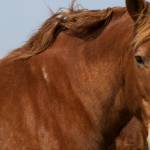Insulin Resistance in Horses May Have Hereditary Factor

Insulin resistance, obesity, cresty necks, equine metabolic syndrome, laminitis. Horse owners hear and read these terms in practically every article that addresses equine health management. More often than not, they come away confused about the relationships, causes, effects, and type of care that will keep their horses healthy. Does a horse get fat because he’s insulin resistant, or does he become insulin resistant because he’s obese? Should he be fed more, or less, or just something different, or is diet not as great a factor as exercise? Some owners may weigh all the facts, shrug their shoulders, and just blame their easy-keeper horses’ problems on bad luck.
When a horse eats any feedstuff—apples, carrots, grass, hay, grain—that contains carbohydrates, the process of digestion releases glucose into the blood. Insulin is released by the pancreas to aid in the uptake of glucose by body tissues. In horses with a normal metabolism, the amount of insulin corresponds to the blood’s glucose level. If the horse produces more insulin than is necessary, the body cells may become resistant to the hormone. This reaction starts a process in which the body continues to produce more and more insulin. Another part of the reaction cues the horse to store more extra energy as fat rather than releasing it as the horse exercises. As the horse slides toward obesity, its adipose (fat) tissue causes body-wide inflammation that can trigger bouts of laminitis.
Despite decades of research, it’s not clear why some horses develop insulin resistance while others that are fed and managed identically stay healthy. Looking back to a time before the phrase “metabolic syndrome” was used, researchers in Australia remembered something that horse fanciers have always known: pony breeds and some horse breeds seem to develop obesity and laminitis quite frequently, while members of other breeds are rarely bothered.
The scientists designed a research plan that used heavy-bodied Andalusian horses and ponies as well as Standardbreds, horses that tend to develop laminitis infrequently. All equines were given oral glucose as well as intravenous glucose. Blood samples were collected every six hours and tested for glucose and insulin levels. Results showed that the Standardbreds needed less insulin and took a shorter amount of time to bring glucose levels back to base level, while the Andalusians and ponies produced a much greater amount of insulin and took longer to clear the glucose. This suggests that genetic makeup of some horse breeds includes a tendency toward developing insulin resistance, while the tendency is not evident in the genome of other breeds.
Does this finding prove that the “just bad luck” explanation is correct? Owners of heavy-bodied equines may think so, especially if they own horses or ponies of mixed or unknown breeding, but management can still go a long way toward minimizing problems caused by insulin resistance. According to Kathleen Crandell, Ph.D., equine nutritionist at Kentucky Equine Research, there are several things owners can do. She advises, “Limiting free grazing, using a medium-grade hay, eliminating large grain meals, cutting out treats, and keeping horses on a schedule of frequent exercise are steps that can help them maintain a desirable body weight and avoid the complications of obesity.”
Another aid for managing horses with insulin resistance is Micro-Max (Gold Pellet in Australia and New Zealand), dietary supplements designed as a low-starch, low-calorie concentrated source of vitamins and trace minerals for all classes of horses. These micronutrient supplements were developed to fortify equine diets while providing minimal caloric intake and reducing glycemic response in horses susceptible to the problems related to insulin resistance.








